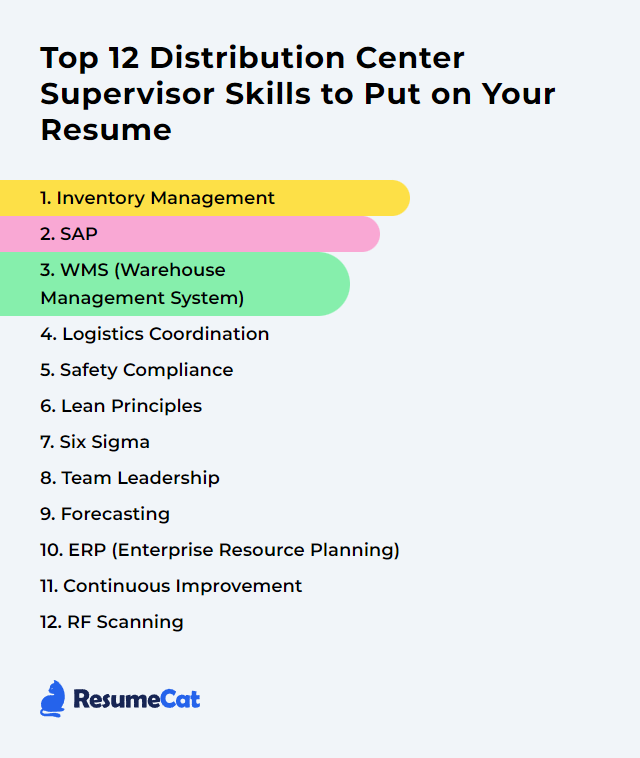Top 12 Distribution Center Supervisor Skills to Put on Your Resume
In logistics and supply chain, a resume that cuts through the noise matters. For distribution center supervisors, the right mix of skills signals control, speed, and calm under pressure. It shows you keep the floor humming, the inventory honest, and the team pointed in the right direction.
Distribution Center Supervisor Skills
- Inventory Management
- SAP
- WMS (Warehouse Management System)
- Logistics Coordination
- Safety Compliance
- Lean Principles
- Six Sigma
- Team Leadership
- Forecasting
- ERP (Enterprise Resource Planning)
- Continuous Improvement
- RF Scanning
1. Inventory Management
Inventory management means steering the flow of goods in, through, and out of the building—knowing what’s where, how much is available, and when to move it. The aim: right stock, right location, right time, at the lowest reasonable cost.
Why It's Important
It stabilizes fulfillment. It caps carrying costs. It keeps customers from waiting and the dock from clogging. Without it, everything wobbles.
How to Improve Inventory Management Skills
Dialing in inventory control calls for clean data, lean practices, and tight routines.
Lean the levels: Align on-hand stock with true demand. Cut dead stock before it eats space and cash.
Use real-time tracking: Barcode or RFID plus a reliable system for live counts and movements. Accuracy first, flash later.
Cycle count with intent: Short, frequent counts to catch drift early. Prioritize high-value and high-velocity items.
Strengthen supplier cadence: Clear order quantities, cadence, and lead-time expectations. Share forecasts and hold each other accountable.
Forecast with evidence: Blend history, seasonality, promotions, and known constraints. Update often; reality changes fast.
Set and track KPIs: Service level, turns, days on hand, accuracy, shrink. Review weekly, fix the root causes.
Train relentlessly: Receiving, binning, picking—standard work and system know-how for everyone touching stock.
Do this well and everything else—speed, cost, customer trust—follows.
How to Display Inventory Management Skills on Your Resume
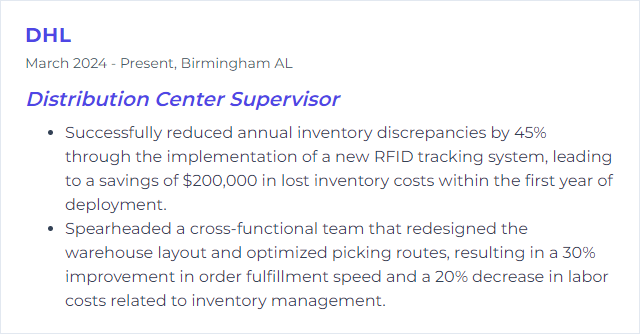
2. SAP
SAP is a comprehensive ERP platform. In distribution, modules like EWM, MM, and SD connect inventory, orders, and shipping so decisions happen with live data, not guesswork.
Why It's Important
It centralizes truth. It reduces manual touchpoints. It powers planning, traceability, and rapid correction when something slips.
How to Improve SAP Skills
Automate what repeats: Standardize inbound, putaway, replenishment, and pick-pack workflows using configured rules.
Tighten data hygiene: Enforce master data standards—units of measure, locations, pack specs—so transactions run clean.
Build useful reports: Create dashboards for aging orders, inventory accuracy, dock performance, and labor productivity.
Invest in training: Refresh roles-based training, cross-train super users, and document playbooks for the floor.
Monitor the right KPIs: Backorders, pick accuracy, dock-to-stock time, warehouse utilization—review and act.
Adopt standard practices: Configure to proven patterns first; customize only when the value is obvious.
Close the loop: Capture user feedback and fix friction fast—screen layouts, workflow steps, exception handling.
Well-tuned SAP becomes invisible, which is exactly the point.
How to Display SAP Skills on Your Resume
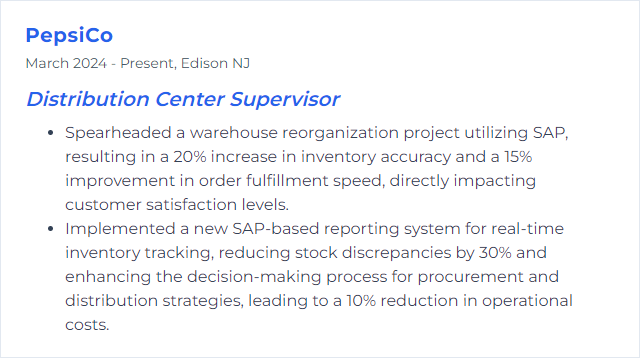
3. WMS (Warehouse Management System)
A WMS orchestrates warehouse work—receipts, putaway, slotting, picking, packing, and shipping—while guarding inventory accuracy and guiding labor to the next best task.
Why It's Important
It sharpens order accuracy, trims travel, leverages space, and speeds outbound. Less waste, more throughput.
How to Improve WMS (Warehouse Management System) Skills
Mine the data: Use heat maps, pick path metrics, and exception logs to target bottlenecks.
Integrate end-to-end: Sync WMS with ERP, TMS, and labor systems so inventory, orders, and shipments tell one story.
Level up training: Standard operating procedures with visual work aids. Floor drills for exceptions and peak playbooks.
Lean into automation: Wave/waveless picking, pick-to-light, AMRs, cartonization rules—where the ROI is real.
Tune slotting: Re-slot by velocity and affinity. Shorten travel, reduce touches, protect fragile SKUs.
Stay current: Apply updates, test thoroughly in a sandbox, and maintain clean configuration control.
Listen to users: Capture daily friction points and remove them—fewer clicks, clearer prompts, smarter exceptions.
When the WMS flows, the building breathes.
How to Display WMS (Warehouse Management System) Skills on Your Resume
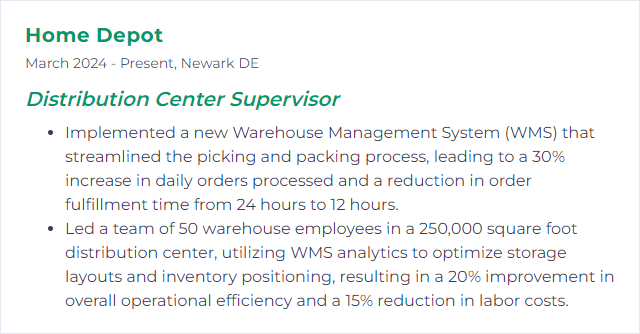
4. Logistics Coordination
Logistics coordination is the choreography of goods: booking carriers, sequencing docks, balancing lanes, and aligning inventory with orders so departures hit windows and arrivals don’t choke space.
Why It's Important
It protects service and cost. It keeps trucks full, routes practical, and customers calm.
How to Improve Logistics Coordination Skills
Plan loads with intent: Consolidate shipments, milk runs where viable, and clear dock schedules posted and enforced.
Refine inventory signals: Tight reorder points and replenishment rules to avoid fire drills at ship time.
Sharpen communication: Real-time updates among warehousing, transportation, and customer service—no surprises.
Use data for routing: Monitor transit time variance, appointment adherence, dwell, and detention. Adjust carriers based on performance.
Build strong partnerships: Clear SLAs, regular reviews, and honest scorecards with carriers and suppliers.
Stress test peak plans: Simulate seasonality and promotions. Pre-book capacity. Add flexible labor early.
Document contingencies: Secondary lanes, backup carriers, re-route rules when weather or capacity flips.
Good coordination replaces chaos with rhythm.
How to Display Logistics Coordination Skills on Your Resume

5. Safety Compliance
Safety compliance means aligning daily work with regulatory requirements and internal standards, reducing exposure to hazards while protecting people, equipment, and product.
Why It's Important
It prevents injuries and downtime, shields the company from fines and claims, and proves you take care of your team.
How to Improve Safety Compliance Skills
Train for the real work: Role-specific, hands-on, and repeated—powered industrial trucks, lockout/tagout, ergonomics, hazard communication.
Audit relentlessly: Housekeeping, racking, guarding, traffic flow, PPE use. Fix fast and verify.
Make reporting easy: Near-miss and incident reporting without fear. Track trends and close actions.
Standardize the floor: Clear signage, marked walkways, right storage heights, stable stacking, compliant charging areas.
Maintain equipment: Daily checks for forklifts and conveyors. Tag out anything suspect.
Stay current: Review applicable regulations and revise procedures when conditions change.
Lead by example: Supervisors model safe behaviors. Every shift. No exceptions.
Culture beats posters. Build it one decision at a time.
How to Display Safety Compliance Skills on Your Resume

6. Lean Principles
Lean trims waste and amplifies value. In a DC, that means smooth flow, fewer touches, smarter layouts, and continuous problem solving where the work happens.
Why It's Important
Lean frees capacity without new buildings. It boosts quality, speed, and morale—while costs quietly slide down.
How to Improve Lean Principles Skills
Define value: What customers actually need and will notice. Strip the rest.
Map the value stream: Visualize steps from receipt to ship. Spot delays, rework, and handoff pain.
Create flow: Balance work, right-size batches, clear choke points, and simplify paths.
Pull, don’t push: Trigger work by demand signals. Control WIP to reduce queues and errors.
Standardize and improve: Lock in the best-known method, then challenge it. Daily Kaizen beats annual overhauls.
Lean isn’t a project. It’s a habit.
How to Display Lean Principles Skills on Your Resume
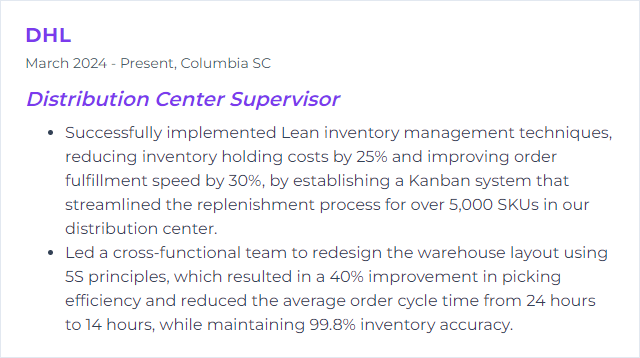
7. Six Sigma
Six Sigma uses data to reduce variation and defects. In distribution, that translates to tighter accuracy, steadier cycle times, and fewer costly surprises.
Why It's Important
It brings rigor to problem solving. You measure, analyze, improve, and control—so improvements stick.
How to Improve Six Sigma Skills
Define the aim: Pick targets like pick accuracy, dock-to-stock, or damage rate. Be specific.
Measure honestly: Baseline with clean data. Use control charts to see the signal beneath the noise.
Analyze causes: Root cause with Pareto, fishbone, and 5 Whys. Validate, don’t assume.
Improve with pilots: Test changes on a slice—layout tweaks, pack standards, labeling fixes—then scale.
Control the gains: SOPs, visual management, audits, and KPI reviews to prevent backslide.
Engage the team: Train belts as needed and involve operators who live the process.
Keep learning: Refresh tools and stay alert to new methods that cut error at the source.
Precision beats heroics every time.
How to Display Six Sigma Skills on Your Resume
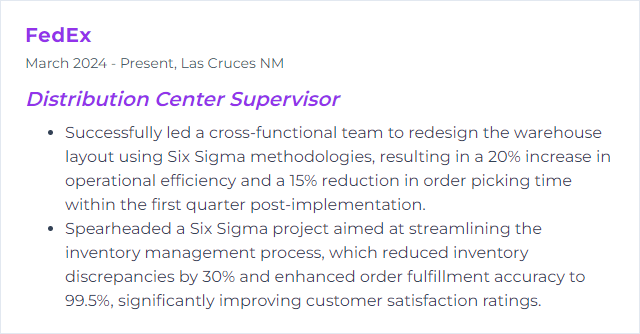
8. Team Leadership
Team leadership is setting direction, clearing obstacles, and developing people so the operation hits its marks day after day.
Why It's Important
People do the work. Strong leadership turns standards into habits and pressure into performance.
How to Improve Team Leadership Skills
Communicate with clarity: Goals, priorities, and feedback—short, specific, respectful.
Model the standard: Safety, quality, pace. Your behavior writes the culture.
Delegate to grow: Assign ownership, not just tasks. Coach, don’t hover.
Build trust: Listen hard. Recognize wins. Address issues quickly and fairly.
Develop skills: Cross-train, certify, and create paths for advancement.
Adapt under pressure: Re-plan calmly, move resources, and communicate changes fast.
Use simple tools: Visual boards, huddles, and daily metrics to align the shift.
Hold the line: Standards matter most when it’s busy.
Teams mirror their leaders. Make that a strength.
How to Display Team Leadership Skills on Your Resume
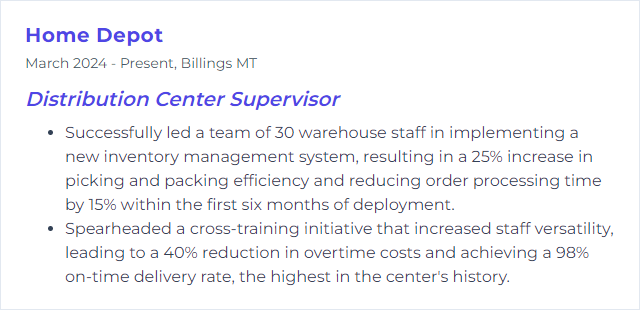
9. Forecasting
Forecasting predicts demand so inventory, labor, and capacity line up before orders drop. It blends data, judgment, and constant correction.
Why It's Important
Miss the forecast and you pay—stockouts, overstock, overtime, and unhappy customers. Get close and the operation runs smoother.
How to Improve Forecasting Skills
Harness history: Spot patterns by SKU and channel—seasonality, promotions, and new product ramps.
Segment wisely: Not all items behave the same. Apply different models to different profiles.
Collaborate: Align with sales, marketing, and suppliers. Share assumptions and note risks.
Update often: Rolling forecasts beat static ones. Adjust when reality deviates.
Measure accuracy: Track MAPE, bias, and forecast value add. Improve the process, not just the number.
Good forecasts are living things. Keep them fresh.
How to Display Forecasting Skills on Your Resume
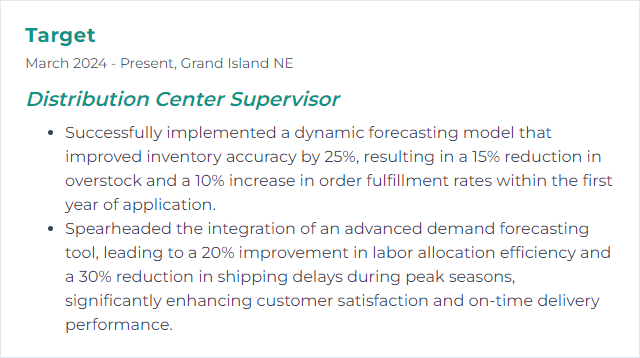
10. ERP (Enterprise Resource Planning)
ERP connects core business processes—procurement, inventory, orders, finance—so the distribution center isn’t flying blind.
Why It's Important
It reduces rekeying, reconciles data, and speeds decisions. One source of truth, many smarter choices.
How to Improve ERP (Enterprise Resource Planning) Skills
Streamline workflows: Map processes, remove duplicate steps, and align approvals with risk.
Capture data at the edge: Use scanning and real-time confirmations to improve accuracy.
Train by role: Tailor access and training to what each role must do well.
Integrate systems: Tie ERP to WMS, TMS, and planning tools so handoffs are automatic and auditable.
Configure before customizing: Keep it maintainable. Customize only for competitive advantage.
Gather feedback: Hold periodic reviews with users to fix pain points and refine screens.
Stay upgraded: Apply supported versions, test thoroughly, and document changes.
When the ERP backbone is strong, everything downstream benefits.
How to Display ERP (Enterprise Resource Planning) Skills on Your Resume

11. Continuous Improvement
Continuous improvement is the daily practice of finding better ways—small fixes and smart experiments that add up to serious gains.
Why It's Important
It keeps costs in check, quality high, and teams engaged. Markets shift; CI makes you nimble.
How to Improve Continuous Improvement Skills
Spot the waste: Walk the floor. Look for waiting, over-processing, motion, defects, and excess inventory.
Prioritize problems: Use simple impact/effort scoring. Tackle a few, finish them, then move on.
Standard work first: You can’t improve what isn’t consistent. Lock in the baseline method.
Run quick experiments: Time-box trials, measure outcomes, keep what works.
Make metrics visible: Post performance daily. Celebrate wins. Learn from misses.
Teach problem solving: Everyone practices root cause and countermeasures, not shortcuts.
Embed the habit: Daily huddles, suggestion loops, and regular retrospectives.
Small improvements, compounded, change the game.
How to Display Continuous Improvement Skills on Your Resume

12. RF Scanning
RF scanning uses handhelds to read barcodes or tags and update systems instantly. It’s the heartbeat of accurate, timely inventory movement.
Why It's Important
It cuts errors, accelerates picking, and tightens traceability. Confidence in every scan.
How to Improve RF Scanning Skills
Train the basics: Grip, angle, distance, and confirm. Teach common failure modes and fixes.
Maintain the fleet: Battery health, firmware updates, and routine hardware checks.
Optimize connectivity: Strong Wi‑Fi coverage, roaming tuned, dead zones eliminated.
Design better labels: High-contrast labels, correct size, smart placement, and durable materials.
Streamline screens: Fewer taps, clear prompts, big buttons. Speed lives in the UI.
Gather user feedback: Frontline suggestions often deliver the fastest wins.
Add protective gear: Holsters, straps, and cases reduce drops and downtime.
Fast scans, clean data, smooth flow.
How to Display RF Scanning Skills on Your Resume

